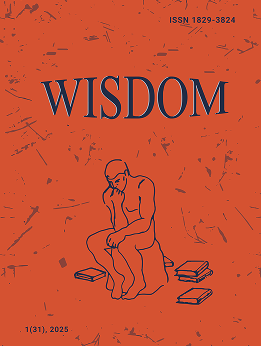The Mechanisms of Forming and Developing Philosophical Thinking Since Early Childhood: Pictorial Philosophy
DOI:
https://doi.org/10.24234/wisdom.v4i1.113Keywords:
Pictorial Philosophy Course, imagery language, natural and formal language, text visualization, text verbalization, unity of concrete and abstractAbstract
The import and usage of Pictorial Philosophy (pictures and schemes, media, video, photo effects, PDF materials and other methods of implementation of visual analysis) in the process of education, enhances and contributes to the formation of children’s world view, the ethical basis of their pre-social behavior, independent and creative thinking. Pictorial Philosophy is also a vital tool for improving efficiency of teachers and instructors, their experience and teaching methods.
In order to adjust philosophy to children, it is necessary to fully understand the philosophical thought and simplify the symbolic language, by enriching it with the power of imagery, overall to explicate the implicit problems in philosophy.
This approach to teaching philosophy can become an essential way and means of organizing education. The implementation of this project is appropriate to start from Armenian State Pedagogical University named after Khachatur Abovyan, particularly in the Faculty of Preschool Education, Faculty of History and Jurisprudence, and Faculty of Special Education
Downloads
References
2. ????????, ?. (2008): ????????? ????????????? ?????: ?????, ??????????????? ?????????? ???????? ????????????????:
3. ????????????, ?. (2015): «??? ???????? ????????????? ???????????? ????????? ???????????? ??? ???????????? ???»: ???????????? 2(3) 2014, ?? 56-75: ?????, «?????? ???» ????:
4. Anderson, R. & Hidde, J. (1971). “Imagery and sentence learning”. Journal of Educational Psychology, 62(6), 526-530.
5. Brutian, G. (2012). “Metaphilosophy in the Systems of Metatheories Metaphilosophy”. In Metaphilosophy LLC and Blackwell Publishing Ltd, Volume 43, Issue 3, pages 294–305, April.
6. Evans, Rod L., Ph.D. (1956). “Thingamajigs and Whatchamacallits: Unfamiliar Terms for Familiar Things”. A Perigee book published by the Penguin Group (USA), Inc., New York, USA.
7. Evans, Rod L. Ph.D. (2007). Every Good Boy Deserves Fudge: The Book of Mnemonic Devices. A Perigee book published by the Penguin Group, (USA), Inc., New York, USA.
8. Evans, Rod L. Ph.D. (2007). Every Good Boy Deserves Fudge: The Book of Mnemonic Devices. A Perigee book published by the Penguin Group, (USA), Inc., New York, USA.
9. Hovhannisyan, H. (2015). Meta-Argumentation as an Argumentation Metatheory. Metaphilosophy, Edited By: Armen T. Marsoobian; Online ISSN: 1467-9973; Volume 46, Issue 3, pp. 479-487, July 2015. http://onlinelibrary.wiley.com/doi/10.1111/meta.12143/ abstract.
10. McDaniel, M. A., & Einstein, G.O. (1986). “Bizarre imagery as an effective memory aid: The importance of distinctiveness”. Journal of Experimental Psychology: Learning, Memory, and Cognition, 12(1), pp. 54-65.
11. Robinson, D. & Groves, J. (2000). Edited by Ricchard Appignanesi. The Introducing... series and the ...For Beginners series of graphic guides covering key thinkers and topics in philosophy, psychology and science, politics, religion, cultural studies, linguistics and other areas. Books are written by an expert in the field and illustrated, comic-book style, by a leading graphic artist. USA.
12. Runes, Dagobert D. (1963). Pictorial History of Philosophy. Paterson, New Jersey. Littlefield, Adams & Co-Paterson.
13. Patton, W. W. (1991). “Opening students’ eyes: Visual learning theory in the Socratic classroom”. Law and Psychology Review, 15, pp. 1-18.
14. Plotnik, Rod H. K. (January 25, 2013). Introduction to Psychology, 10th Edition. Canada: Wadsworth Publishing, Cengage Learning.
15. Verdi, M., Johnson, J., Stock, W., Kulhavy, R., Whitman-Ahern, P. (1997). “Organized spatial displays and texts: Effects of presentation order and display type on learning outcomes”. Journal of Experimental Education, 65, pp. 303-317.
16. McDaniel, M. A., & Einstein, G. O. (1986). “Bizarre imagery as an effective memory aid: The importance of distinctiveness”. Journal of Experimental Psychology: Learning, Memory, and Cognition, 12(1), pp. 54-65.
17. Verdi, M. P., Johnson, J. T., Stock, W. A., Kulhavy, R. W., Whitman-Ahern, P. (1997). “Organized spatial displays and texts: Effects of presentation order and display type on learning outcomes”. Journal of Experimental Education, 65, pp. 303-317.
18. ???????, ?. (2010). ??????? ????????? ? ?????? ? ????????????. ?????, ???.-?? ???, ?????: ??????? ???????.
19. ?????, ?. (1972). ???? ? ??????????? ??????????. ??????, ???.-?? «???». 200 ?.
20. ?????, ?. (2001). ??????????? ???????? ?????????: ??????? ??????? ? ?????????????. ??????, ???.-?? «????????».
21. ???????????????? ??????????? ??????? (2004). ??????, ???.-?? "?????????? ?????".
Downloads
Published
How to Cite
Issue
Section
License
Creative Commons Attribution-Non-Commercial (CC BY-NC). CC BY-NC allows users to copy and distribute the article, provided this is not done for commercial purposes. The users may adapt – remix, transform, and build upon the material giving appropriate credit, and providing a link to the license. The full details of the license are available at https://creativecommons.org/licenses/by-nc/4.0/.















